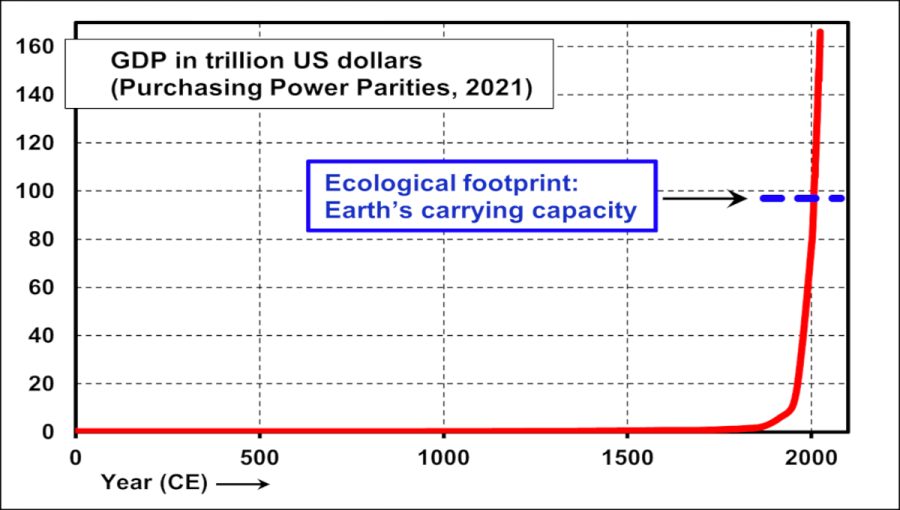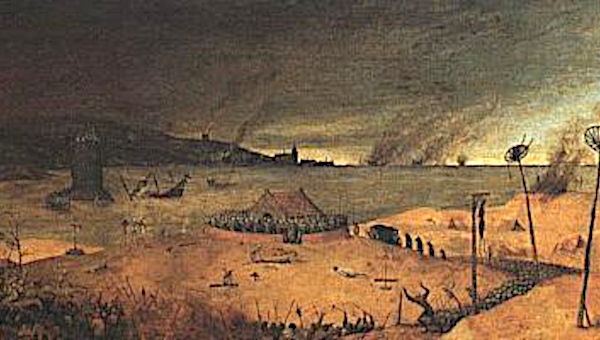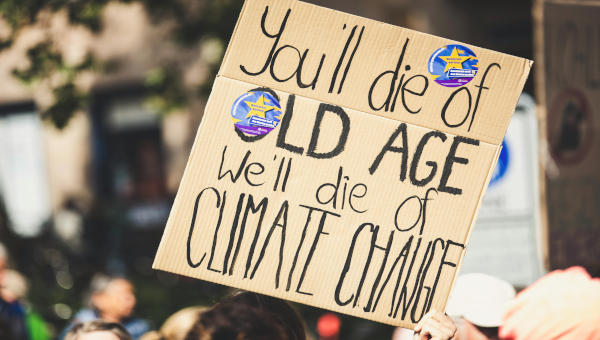The Case for Protecting the Tongass National Forest, America’s ‘Last Climate Sanctuary’
Spanning 16.7 million acres that stretch across most of southeast Alaska (west of the Canadian border), the Tongass National Forest is the largest national forest in the United States by far and part of the world’s largest temperate rainforest. Humans barely inhabit it: about the size of West Virginia, the Tongass has around 70,000 residents spread across 32 communities.
A vast coastal terrain replete with ancient trees and waterways, the Tongass is a haven of biodiversity, providing critical habitat for around 400 species, including black bears, brown bears, wolves, bald eagles, Sitka black-tailed deer, trout, and five species of Pacific salmon.
The Tongass is a pristine region that supports a vast array of stunning ecosystems, including old-growth forests, imposing mountains, granite cliffs, deep fjords, remnants of ancient glaciers that carved much of the North American landscape, and more than 1,000 named islands facing the open Pacific Ocean – a unique feature in America’s national forest system.
The Tongass “is the crown jewel of America’s natural forests,” declared then-Senator Barbara Boxer (D-CA) during Senate deliberations of Interior Department budget appropriations in 2003. “When I was up there, I saw glaciers, mountains, growths of hemlock and cedar that grow to be over 200 feet tall. The trees can live as long as a thousand years.”
The National Forest Foundation calls the Tongass National Forest “an incredible testament to conservation and nature.” But since the 1950s, the logging industry has prized the forest, and the region has been threatened by companies that seek to extract its resources – and the politicians who support these destructive activities.
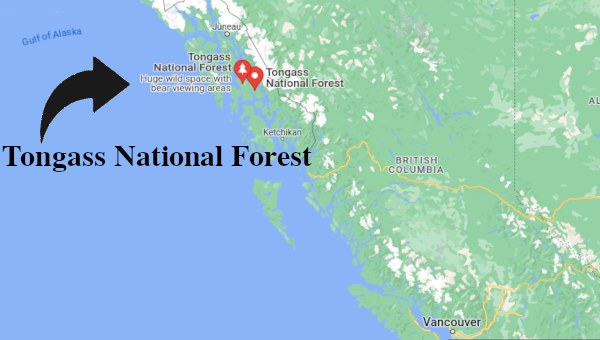
America’s Largest Carbon Sink
Carbon sinks absorb more carbon from the atmosphere than they release, making them essential to maintaining natural ecosystems and an invaluable nature-based solution to the climate crisis. Between 2001 and 2019, the Earth’s forests safely stored about twice as much carbon dioxide as they emitted, according to research published in 2021 in the journal Nature Climate Change and available on Global Forest Watch.
The planet’s forests absorb 1.5 times more carbon than the United States emits annually – around 7.6 billion metric tons. Consequently, maintaining the health of the world’s forests is central to humanity’s fight against climate change. But rampant deforestation and land degradation are not only removing this invaluable climate-regulating ecosystem service and supporter of biodiversity but also disturbing a healthy, natural planetary system that has existed for millennia.
“There is a natural carbon cycle on our planet,” said Vlad Macovei, a postdoctoral researcher at the Helmholtz-Zentrum Hereon in Germany. “Every year, some atmospheric carbon gets taken up by land biosphere, some by the ocean, and then cycled back out. These processes had been in balance for the last 10,000 years.”
Carbon sinks like the Tongass are vital environmental protectors by sequestering carbon dioxide and preventing this greenhouse gas from entering the atmosphere, where it can fuel global warming. And because “it contains the [Earth’s] largest intact stands of coastal temperate rainforest,” the Tongass acts as one of the world’s most effective carbon sinks. In this way, the Tongass provides a key “ecosystem service” – a benefit humans receive from nature that helps sustain life – not just for the US but also for the entire planet.
“Basically, when you go through an old-growth forest, you’re walking through a stick of carbon that has been built up into the forest for many, many decades, [even] centuries,” said Dominick DellaSala, chief scientist at Wild Heritage, a project of Earth Island Institute, a nonprofit environmental organization based in Berkeley, California. DellaSala was part of a research team that found that the Tongass holds approximately 44 percent of all carbon stored by US national forests. The team’s research was published in 2021 by the Woodwell Climate Research Center, based in Falmouth, Massachusetts.
“[T]he largest trees in those forests store about 50 percent of the above-ground carbon, so they are enormously important from a carbon standpoint,” said DellaSala.
These undisturbed forest lands are increasingly scarce and, therefore, increasingly valuable ecosystems. “While tropical rainforests are the lungs of the planet, the Tongass… [acts as] the lungs of North America,” DellaSala told PBS in 2020. He calls the Tongass “America’s last climate sanctuary.”
“The Tongass National Forest provides us with the greatest opportunity in the nation, if not the world, for protecting temperate rainforest at the ecosystem scale, in the face of climate change,” according to Audubon Alaska, a nonprofit conservation organization. “It sequesters more carbon than any other type of forest on Earth, providing a much-needed opportunity for climate solutions that can simultaneously bolster regional economies.”
Unfortunately, as the US Environmental Protection Agency points out, “ecosystem services are important to environmental and human health and well-being… [but they are] often taken for granted.”
Impact of Logging
Jerry Melillo, a scientist at the Ecosystems Center of the Marine Biological Laboratory at the University of Chicago, noted, “[o]ver the past 8,000 years, humans have cleared up to half of the forests on our planet, mostly to make room for agriculture.” This has hampered the Earth’s natural ability to regulate the climate, allowing more greenhouse gases to escape into the atmosphere, thus exacerbating global warming.
“Cutting down or burning forests releases the carbon stored in their trees and soil and prevents them from absorbing more CO2 in the future,” he wrote. “Since 1850, about 30 percent of all CO2 emissions have come from deforestation. Deforestation can also have more local climate impacts. Because trees release moisture that cools the air around them, scientists have found that deforestation has led to more intense heat waves in North America and Eurasia.”
In the 1950s, the Forest Service contracted with two US timber companies to build pulp mills near Ketchikan and Sitka. As part of the agreements, the agency promised to sell the firms a total of 13.5 billion board feet of Tongass timber over a 55-year period. These contracts massively accelerated logging in the region.
Since these contracts were signed, “more than 1 million acres of the Tongass have been clearcut,” according to the Southeast Alaska Conservation Council. Adding economic insult to ecological injury, the federal government consistently loses money from logging contracts in the Tongass. According to a 2020 report by Taxpayers for Common Sense, an independent, nonpartisan advocacy group, the Forest Service has lost more than $1.7-billion on Tongass timber sales since 1980. “It actually costs taxpayers millions to ‘sell’ timber that we collectively own, which makes no sense,” said Autumn Hanna, the group’s vice president.
“Scientists have long understood that logging old-growth forests triggers a cascade of negative effects on wildlife, eroding the biodiversity of places like the Tongass,” wrote Rebecca Bowe of Earthjustice, a nonprofit environmental organization headquartered in San Francisco, in 2021. “Clear-cutting old-growth… transforms ancient forests into carbon emitters.”
Women’s Earth and Climate Action Network, International (WECAN International) is a climate activist group that works with Earthjustice to end the destruction of old-growth logging in the Tongass. “The Tongass has been called ‘America’s Climate Forest’ due to its unsurpassed ability to mitigate climate impacts,” said Osprey Orielle Lake, WECAN’s executive director, in 2021. “For decades, however, industrial-scale logging has been destroying this precious ecosystem and disrupting the traditional lifeways, medicine, and food systems of the region’s Indigenous communities.”
World’s Largest Wild Salmon Population
The Tongass ecosystem supports some of the world’s largest remaining wild salmon populations. The lakes, rivers, and streams of the Tongass produce some 50 million salmon every year – more wild salmon than all of the other US national forests combined.
“One of the things that the Forest Service is interested in doing is estimating the value of the different activities and services that national forests provide,” said J. Ryan Bellmore, a biologist who co-authored a 2019 study, the first of its kind, that estimated the value of the Tongass and the Chugach National Forests to the commercial salmon industry in Alaska. “And the Tongass and the Chugach provide a lot of salmon.”
According to the study, the wild salmon born within the boundaries of the Tongass and the Chugach make up around 25 percent of Alaska’s commercial Pacific salmon catch and 16 percent of the total commercial value of salmon caught in the state every year. Commercial fishermen caught an average of 48 million “forest salmon” in Alaska yearly during the 10-year-long study period. That amount of salmon translated to an annual average commercial value of $88-million.
What these Alaskan fisheries provide goes beyond their quantifiable and significant economic benefit and food source for the people of Alaska and beyond. The salmon have also been part of the traditional way of life for the Indigenous Tribes of the region for millennia. “For over 9,000 years, the [I]ndigenous people of the region have survived because of the salmon,” wrote Brian Footen, a fish biologist who has worked with Tribal, federal, and state fishery departments in Washington state for over two decades. And the fish are also critical for the survival of wildlife, supporting healthy populations of bald eagles, wolves, and brown bears, which in turn, support the entire web of life across the region.
Importance to Indigenous Tribes
The Tongass contains the traditional homelands of the Tlingit, Haida, and Tsimshian peoples, and its well-being is essential to these groups’ traditional way of life, health, and cultural identity. Even the name of the forest itself is wrapped up in Indigenous identity: Translated, “Tongass” means “Sea Lion Tribe,” one of the main divisions of the Tlingit people living at Portland Canal, located at the border between southeastern Alaska and British Columbia.
Joel Jackson, president of the Organized Village of Kake Tribal Council, noted that these Indigenous groups are “tied to our lands that our ancestors walked on thousands of years ago. … The land still provides food security – deer, moose, salmon, berries, our medicines. The old-growth timber is important in keeping all these things coming back year after year,” Jackson said, adding, “especially our salmon, because the trees keep our streams cool.” Maintaining these plentiful resources season after season requires a healthy Tongass.
“I identify my ancestry through descent-based kin groups indigenous to the Tongass Forest and recognize that we are all tied to each other – not independents,” said Wanda “Kashudoha” Loescher Culp, a Tlingit activist, in a statement to federal lawmakers in 2019 urging increased protections for the Tongass.
“Our food gathering and all other resource harvesting methods seriously involve the thanking of the recognized life we are taking for our benefit. We successfully use every ‘resource’ the Tongass offers wisely, efficiently, without waste, and in gratitude,” said Culp, who is also the coordinator for WECAN Tongass.
In addition to being a year-round natural “supermarket,” the Tongass is a powerful spiritual place for the Tribes who have called it home for generations.
Importance to Jobs and Economy
Because of its natural beauty and opportunity for outdoor recreational activities like camping, boating, canoeing, fishing, hiking, and birdwatching, the Tongass is home to a vigorous and ever-expanding tourism industry.
The Tongass welcomes more than 2.8 million visitors each year, which generates “more than $380-million in spending and over 5,000 jobs,” according to the USFS. In particular, the cruise industry provides vital economic inputs to the local economies across southeast Alaska. “The vast majority of visitors to Southeast Alaska are cruise ship passengers,” according to the USFS.
“Hundreds of thousands of tourists visit the Tongass each summer in the hopes of experiencing its magnificence: 200-foot-tall spruce and 500-year-old cedar trees soaring overhead,” states Alaska Conservation Foundation, the only public foundation dedicated solely to conservation in Alaska. “Amid the lush ferns and mossy remnants of fallen trees, one might see a brown bear ambling its way to a salmon stream, in search of its next meal. There is simply no place else like it.”
Tongass Timber Reform Act of 1990
In 1990, President George H.W. Bush signed into law the Tongass Timber Reform Act (TTRA), which was crafted as an amendment to the Alaska National Interest Lands Conservation Act (ANILCA) of 1980, a federal law signed by President Jimmy Carter that established protection for more than 100 million acres of federal land in Alaska from development by designating “conservation system units,” including national parks, national wildlife refuges, and designated wilderness areas.
The main goal of the TTRA – which enjoyed massive congressional support, passing in the Senate 99 to 0 – was to increase the protection of the Tongass National Forest from the ecological harms of industrial logging by designating approximately 856,000 acres as roadless areas so that large swaths of old-growth forest would “retain their wildland character.” Specifically, the act was intended “to protect certain lands in the Tongass National Forest in perpetuity, to modify certain long-term timber contracts, [and] to provide for [the] protection of riparian habitat.”
Following the law’s enactment, Alaska Pulp Corporation and Ketchikan Pulp Company, two industrial pulp mills located in southeast Alaska, ended their operations in 1993 and 1997, respectively. Alaska’s congressional delegation blamed the closures on environmentalists, the TTRA, and the Clinton administration “for destroying an industry that had been the region’s largest private employer,” wrote Rich Moniak, in a column for Juneau Empire in which he called that narrative a “fiction.”
The “TTRA was not a substantial factor – indeed, no factor at all – in the closure of the pulp mill and the resulting termination of the contract,” concluded Lawrence M. Baskir, the US Court of Federal Claims judge who presided over the lawsuit that Alaska Pulp Corporation filed in 1994, a year after it closed its mill, in part due to declining demand for softwood pulp.
Bart Koehler, the executive director of Southeast Alaska Conservation Council from 1984 to 1991 and from 1995 to 1999, who was part of the grassroots effort to pass the Tongass Timber Reform Act, called the law “the most significant piece of conservation law signed by President George H.W. Bush.”
The Roadless Rule of 2001
In 1999, President Bill Clinton instructed the USFS to develop regulations to protect the nation’s roadless areas. The administration aimed to protect the nation’s biodiversity, air and water quality, opportunities for public recreational activities, and local economies. “In the final regulations, the nature and degree of protection afforded should reflect the best available science and a careful consideration of the full range of ecological, economic, and social values inherent in these lands,” Clinton stated at the time.
Issued in 2001, the Forest Service’s “Roadless Rule” is a federal regulation prohibiting most timber cutting and road building in specific forest lands known as “Inventoried Roadless Areas.” The Roadless Rule protects 58.5 million acres or 31 percent of lands within the federal National Forest System (NFS), which together amounts to about 2 percent of the total land base of the United States.
“Inventoried roadless areas provide benefits to over 220 wildlife species listed as either threatened, endangered, or proposed by the Endangered Species Act – approximately 25 percent of all animal species and 13 percent of all plant species,” according to the USFS. “The intent of the 2001 Roadless Rule is to provide lasting protection for inventoried roadless areas within the National Forest System,” the agency states.
Trump Administration Rollback of Roadless Rule
The 2001 Roadless Rule designates and manages as inventoried roadless areas more than half of the Tongass National Forest – around 9.2 million acres. On October 29, 2020, in the final days of his presidency, Trump repealed the Roadless Rule from the Tongass, opening up a section of the forest to road-building and industrial activity. Trump’s USDA issued a notice saying that the final plan would open up 186,000 acres for timber production. GOP leaders welcomed the decision.
Republican Senator Lisa Murkowski of Alaska, who was at the time the chair of the Senate Energy and Natural Resources Committee, noted that Trump’s repeal of the Roadless Rule would help the state develop not only public infrastructure to help connect the isolated communities in the area but also cheaper sources of energy.
Industry groups also supported the decision. “There’s a handful of small operators that are working on the Tongass, harvesting timber,” Tessa Axelson of the Alaska Forest Association, a timber industry group, told Alaska Public Media. “In order to continue to survive, those businesses are dependent on a predictable supply of timber.”
Frank Bergstrom, a mining consultant in Juneau, said the rollback could attract investors to mineral exploration in the region. “There’s no roadmap to these things,” he said. “Maybe it’ll lead to a little more optimism. … This is one obstacle that has at least been diminished.”
Environmental groups decried the move. “Logging the Tongass is an unconscionable leap in the wrong direction,” said Jennifer Rokala, executive director for the Center for Western Priorities, a nonpartisan conservation advocacy group.
“Americans already pay $30-million annually to subsidize commercial logging operations on the portion of the Tongass not covered by the roadless rule. This proposed decision would increase the costs to taxpayers by opening the most remote areas of the forest to clear-cutting,” said Ken Rait, project director for US public lands and rivers conservation at Pew Charitable Trusts. “The Tongass is a global gem. Once these pristine forests are gone, they’re gone forever.”
The Trump administration rollback went against overwhelming public opposition: Only 1 percent of public comments submitted to the federal government during the US Forest Service’s environmental review supported lifting the existing safeguards on the Tongass.
Statewide polling in Florida, Michigan, Pennsylvania, and Wisconsin – all battleground states – conducted in 2020 also revealed strong opposition to the Trump administration’s decision to lift longtime environmental protections and open the Tongass to expanded logging operations.
Following the poll’s release, J.D. Hayworth, a Republican former member of Congress who represented Arizona from 1995 to 2007 and spent the majority of his six terms in office on the House Resources Committee, warned the Trump campaign months before Trump’s decision to lift the Roadless Rule in the Tongass was finalized that the move would hurt his chances at reelection.
“Now, with less than 75 days until election day, the Trump campaign needs to listen to the concerned voices of their base whose wavering support for Trump could be pushed further into the Biden camp if Trump moves forward with lifting protections in America’s largest and most important national forest,” Hayworth wrote in an opinion piece published by Bloomberg Law in August 2020.
After Trump lost the 2020 presidential election, his revocation of the Roadless Rule would remain for about two more years. The Roadless Rule was important enough to the incoming Biden administration that on his first day in office, Biden committed to reviewing the 2020 Alaska Roadless Rule of his predecessor as one “that may conflict with important national objectives including protecting the environment.” Still, reinstating the 2001 rule would still take around two years, as the Biden administration went through the lengthy federal review process, including months of allowing the public to comment. In addition, there was an ultimately failed lawsuit filed by the resource industries and the state of Alaska attempting to maintain Trump’s rollback that had to make its way through the court system.
Biden Administration Reinstatement of the Roadless Rule
In July 2021, six months after he took office, President Biden froze old-growth timber sales in the Tongass as the administration began the lengthy process to reinstate the Roadless Rule. “The announcement that large-scale, old-growth logging is going to be ceased is very positive… because those mass clear cuts are not going to occur here anymore,” said Marina Anderson, Tribal administrator for the Organized Village of Kasaan on Prince of Wales Island.
Finally, in January 2023, the Biden administration was able to reinstate the Roadless Rule on Alaska’s Tongass National Forest, which brought back the 2001 protections that had been in place. The decision made constructing roads and harvesting timber inventoried roadless areas illegal, with limited exceptions.
“As our nation’s largest national forest and the largest intact temperate rainforest in the world, the Tongass National Forest is key to conserving biodiversity and addressing the climate crisis,” said Agriculture Secretary Tom Vilsack. “Restoring roadless protections listens to the voices of Tribal Nations and the people of Southeast Alaska while recognizing the importance of fishing and tourism to the region’s economy.”
In a press release issued on January 25, 2023, the US Department of Agriculture said that the reinstatement of the Roadless Rule in the Tongass was “based on the multiple ecological, social, cultural, and economic values supported by roadless areas on the Tongass, and… [followed] months of engagement with Tribes, rural communities, and partners.” The agency noted that the majority of the approximately 112,000 comments that the Forest Service received from organizations and individuals during the public comment period (from November 2021 to January 2022) were in favor of the reinstatement of the Roadless Rule, adding that the USDA consulted with the Tribal Nations of Southeast Alaska before the decision was made.
This executive order protects not only a pristine, climate-protecting ecosystem and source of economic stability and growth for Alaska but also the traditional and customary hunting, fishing, and gathering areas for future generations of Southeast Alaska Tribes. It also protects an attraction for the millions of visitors whom it welcomes every year from across the nation and the globe. In addition to securing important wildlife and fish habitat, opportunities for recreation, and traditional and sacred sites, roadless areas in the Tongass will prevent the kind of intensive industrial development and resource extraction that have destroyed forests worldwide, many of which are damaged beyond repair.
As mentioned, preventing roads from being built in the Tongass has widespread popular support. According to the USFS, 96 percent of the 1.6 million letters and comments submitted during 600 public meetings supported the roadless initiative in the Tongass. Notably, most Alaskans were in support of maintaining roadless areas.
Republicans Denounce Reinstatement
Unsurprisingly, several leading Alaskan Republicans were quick to slam the Biden administration’s decision to reinstate the Roadless Rule in the Tongass.
“The Roadless Rule should never have applied to the Tongass, and the Biden administration’s decision to reinstate it is federal paternalism at its worst,” said Senator Murkowski. “Roughly 80 percent of the Tongass is already protected through existing law, land use designations, and the forest planning process, and there is no threat of large-scale development from timber harvesting or any other activity.”
This, of course, is not true. In fact, the reinstated rule does not stop public road-building or other necessary projects. Since 2009, the USFS received and approved 59 project proposals under the Roadless Rule that support power generation, access between communities, and other priorities.
Road-building of any sort is a direct threat to wildlife habitat. While much of the Tongass does have federal protection, what Murkowski fails to recognize is that existing manmade structures in the forest have already hampered the ability of wildlife to live in their natural state. Manmade road-stream crossings, including bridges and culverts, have fragmented natural aquatic habitats that impeded fish migrations. As of 2019, according to the USFS, 1,120 fish stream crossings – 30 percent of the total surveyed within the Tongass – fail to meet current standards for fish passage. Adding noncritical roads would only increase this kind of wildlife habitat fragmentation and add undue stress to many species.
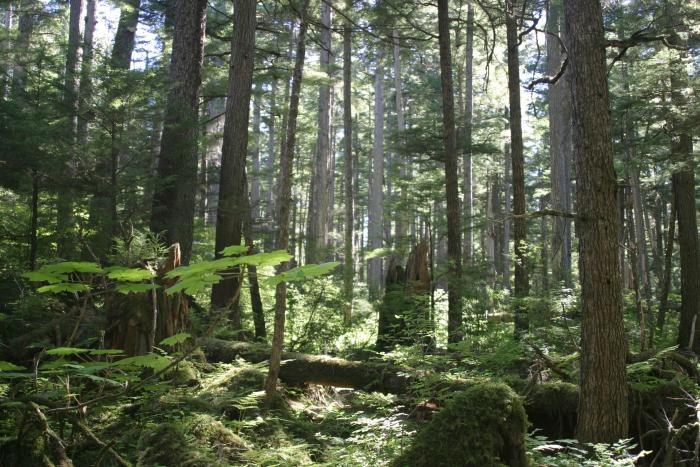
Indigenous Tribes Welcome Reinstatement of Roadless Rule
The return of Roadless Rule protections to the Tongass represents a commitment from the USFS not only to address the climate crisis but also to respect the natural integrity of the ancestral homeland of Southeast Alaska Tribes, who – like so many Indigenous groups across the globe – continue to be disproportionately impacted by climate change.
Following the Biden administration’s reinstatement of the Tongass Roadless Rule in 2023, a coalition of Southeast Alaska Tribal leaders – including the Organized Village of Kake, the Organized Village of Kasaan, the Ketchikan Indian Community, the Skagway Traditional Council, the Organized Village of Saxman, the Hoonah Indian Association, the Craig Tribal Association, and the Central Council of the Tlingit and Haida Indian Tribes of Alaska – issued cautious praise for the move, making sure they were afforded agency in decisions that would impact the future of the region.
“As the Forest Service works to repair relationships with Southeast Tribes,” the leaders wrote in a press statement sent to the Independent Media Institute on January 25, 2023, “it is critical that the federal government ensure that the Southeast Tribal leaders be integral partners in creating a future for the Tongass that is guided by Indigenous values, a genuinely sustainable economy, and a healthy ecosystem – all of which will sustain the Tongass for future generations.”
In January 2023, following the reinstatement of the Roadless Rule, a group of Tribal leaders from the Tongass region issued a statement that said, in part, “We have engaged tirelessly throughout the Roadless Rule process – some of us for more than 20 years – to bring Tribal concerns to the forefront of the conversation through consultation and legal means.”
“Throughout time, many of our concerns fell on deaf ears,” said the Organized Village of Kake’s Joel Jackson in a statement emailed to the Independent Media Institute on March 21, 2023. “Now that the US Forest Service is listening to Tribal concerns and reinstating the Tongass Roadless Rule, we are optimistic that we will be able to create long-term protections.”
“The return of 2001 Roadless Rule protections [to the Tongass also] signals a commitment from the… [US Forest Service] to address the climate crisis and finally listen to the Southeast Tribes that will continue to be most impacted by climate change effects,” said Jackson.
These federal protections include possible co-management compact agreements “for areas inherent to our traditional and cultural uses through our Administrative Procedures Act Petition to Create a Traditional Homelands Conservation Rule,” the leaders’ statement said. Tribes also support the 2021 Southeast Alaska Sustainability Strategy (SASS). The strategy will end large-scale old-growth timber sales in the Tongass National Forest. It will instead focus on forest restoration, recreation, and resilience while identifying opportunities for investments through meaningful consultation with Tribes.
Going even further, Southeast Alaska Tribes will continue working toward permanent forest protection. The Roadless Area Conservation Act was introduced in the House in 2021 to put these protections in place.
The seesaw of the Roadless Rule between presidential administrations shows that executive orders can be issued and rescinded. The only way to prevent this back-and-forth policy would be for lawmakers to enshrine protections for the Tongass in state and federal law or for the judiciary to clarify the Roadless Rule’s original intent to protect the Tongass.
“The uncertainty with the Roadless Rule has been a debilitating factor for the last 20 years, and I do not see that ending unless the courts put a stop to it – the political revolving door will keep it in play as long as there are elections,” wrote Robert Venables, executive director of the Southeast Conference. This southeast Alaska regional economic development group supported the Roadless Rule revision in 2020.
Global Pledge to End and Reverse Deforestation
Leaders at the November 2021 COP26 climate talks in Glasgow signed a pledge to end and reverse deforestation and land degradation by 2030, with 144 nations joining. The commitment, titled the “Glasgow Leaders’ Declaration on Forests and Land Use,” collectively includes at least 90 percent of the Earth’s forests – amounting to more than 13 million square miles – and is supported by a $19-billion investment fueled by both private and public funds.
“Conserving our forests and other critical ecosystems is… an indispensable piece of keeping our climate goals within reach,” said US President Joe Biden at the Glasgow conference. “If we all work together to make sure these precious resources are conserved… forests have the potential to reduce… carbon globally by more than one-third… So, we need to approach this issue with the same seriousness of purpose as decarbonizing our economies. That’s what we’re doing in the United States.”
Biden went on to mention the Tongass specifically, saying, “We have put in place protections for the Tongass Forest in Alaska, the world’s largest intact temperate rainforest.” He also announced a “new plan to conserve global forests, which will bring together a full range of US government tools – diplomatic, financial, and policy – to halt forest loss, restore our critical carbon sinks, and improve land management. Through this plan, the United States will help the world deliver on our shared goal of halting natural forest loss and restoring at least an additional 200 million hectares of forests and other ecosystems by the year 2030.”
That is a massive amount of land. To put that figure into context, 200 million hectares is about 770,000 square miles – eclipsing the size of the state of Alaska by more than 100,000 square miles. The area is bigger than many nations, including Mongolia, Indonesia, and Mexico.
Environmental advocates cheered the move. Darci Vetter, global head of policy and government relations at the Nature Conservancy, an environmental nonprofit, called Biden’s executive order “a clear recognition of the critical role forests play for our climate and our communities. This science-based, cooperative approach to forest conservation and restoration is a smart strategy we should accelerate and amplify.”
Conclusion
Based on scientific evidence, it is clear that the Tongass National Forest is an important carbon sink not just for the United States – where it stores more than 40 percent of all the carbon stored by all the national forests – but also for the world at large, being the Earth’s largest remaining temperate rainforest.
The Tongass is also home to a rich diversity of plant and animal species, many of which are unique and found nowhere else in the world. It is a refuge for numerous endangered and threatened species, including the iconic bald eagle and the Alexander Archipelago wolf. Preserving this habitat ensures the continuation of these species and maintains the ecosystem’s delicate balance.
If the Tongass were subject to large-scale development, irreversible damage would be inflicted upon this unique ecosystem. Deforestation and infrastructure projects could lead to habitat fragmentation, loss of biodiversity, and disruption of critical ecological processes.
Additionally, the Tongass National Forest is a significant driver of Alaska’s sustainable economy, particularly fishing, tourism, and recreation. The forest attracts visitors worldwide, drawn to its stunning landscapes, abundant wildlife, and outdoor recreational opportunities. The commercial fishing industry, which heavily depends on the health of the forest’s rivers and streams, also benefits from its protection.
Crucially, the forest is deeply woven into the cultural fabric of Indigenous communities like the Tlingit, Haida, and Tsimshian peoples, who have relied on its resources for millennia. It holds spiritual, cultural, and traditional values, making its preservation essential for respecting the rights and heritage of these native groups.
Following the Biden administration’s reinstatement of the Roadless Rule in January 2023, Dr. Homer Wilkes, the USDA under-secretary for natural resources and environment, said, “Protecting the Tongass will support watershed protection, climate benefits, and ecosystem health and protect areas important for jobs and community well-being – and it is directly responsive to input from Tribal Nations.”
In their January 2023 statement, Southeast Alaskan Tribal leaders said, “As the USDA works to repair its relationship with our Tribal governments and communities on the ground, the agency will continue to be an integral partner in creating a future for the Tongass that is guided by collaboration, Indigenous leadership and values, the needs of future generations, and sustainable economies that will heal the divisions of the past.”
Preserving the integrity of Tongass National Forest is crucial for the Earth’s well-being. By safeguarding this irreplaceable ecosystem and awe-inspiring landscape, humanity can achieve many positive outcomes, from combatting the impacts of the climate crisis and protecting biodiversity to honoring Indigenous cultures and sustainably supporting local economies. As the Tongass is part of the United States, it is the responsibility of all Americans to act as stewards of this natural treasure, ensuring that future generations can continue to benefit from its immense ecological and cultural value. •
This article was produced by Earth | Food | Life, a project of the Independent Media Institute.


